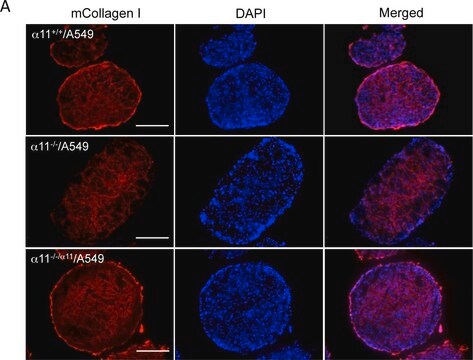E9402
EphB2/Fc Chimera from mouse
>90% (SDS-PAGE), recombinant, expressed in NSO cells, lyophilized powder
Synonym(s):
Cek5, Drt, ERK, Hek5, Nuk, Qek2, Sek3, Tyro5
Sign Into View Organizational & Contract Pricing
All Photos(1)
About This Item
Recommended Products
biological source
mouse
Quality Level
recombinant
expressed in NSO cells
Assay
>90% (SDS-PAGE)
form
lyophilized powder
potency
0.04-2.5 ng/mL
mol wt
monomer calculated mol wt 85.3 kDa
100-110 kDa by SDS-PAGE (reducing)
packaging
pkg of 200 μg
storage condition
avoid repeated freeze/thaw cycles
technique(s)
ligand binding assay: suitable
impurities
endotoxin, tested
UniProt accession no.
storage temp.
−20°C
Gene Information
mouse ... Ephb2(13844)
General description
EphB2 (Epherin receptor B2) is a receptor tyrosine kinase (RTK), which belongs to a 13 member family of ephrin receptors. This family is divided into two classes A and B. EphB2 belongs to EphB group, which contains five members. The ligands to this group of receptors are named ephrin-B1-B3. It is a bidirectional functioning membrane protein.
Application
EphB2/Fc Chimera from mouse has been used for the investigation of the role of ephrinB-EphB signaling in the induction and maintenance of hyperalgesia, hyperexcitability of neurons of DRG (dorsal root ganglion) and hyperexcitability and elevated synaptic plasticity of neurons of DH (dorsal horn) regions of brain.
Biochem/physiol Actions
EphB2 (Epherin receptor B2) is involved in the development and plasticity of glutamatergic synapses, and their interaction with NMDA receptor. It can also regulate the processing of acute inflammatory pain, and mechanical allodynia as a result of nerve crush. Activation of this receptor results in recruitment and activation of Src-protein kinases. These, in turn, phosphorylate and activate NMDA receptor. It regulates the function of platelets and the development of thrombus. It is also responsible for the retraction of clots, and modulates independent platelet function in a contact-independent manner. EphB2 signaling is also involved in the modulation of axonal sprouting, which is induced by lesions.
Member of the Eph receptor tyrosine kinase family shown to bind ephrin-B1, ephrin-B2, and ephrin-B3; involved in pattern formation and morphogenesis, and in arterial/venous demarcation of the developing vasculature.
Other Notes
Extracellular domain of mouse EphB2 (amino acids 1-548) fused to the C-terminal 6X histidine-tagged Fc region of human IgG1 via a polypeptide linker.
Physical form
Lyophilized from a 0.2 μm filtered solution in 20 mM Tris, pH 8.0.
Analysis Note
The biological activity is measured by its ability to bind recombinant mouse ephrin-B2/Fc in an ELISA assay.
Storage Class Code
11 - Combustible Solids
WGK
WGK 3
Flash Point(F)
Not applicable
Flash Point(C)
Not applicable
Personal Protective Equipment
dust mask type N95 (US), Eyeshields, Gloves
Choose from one of the most recent versions:
Already Own This Product?
Find documentation for the products that you have recently purchased in the Document Library.
Sakthivel Vaiyapuri et al.
Blood, 125(4), 720-730 (2014-11-06)
The Eph kinases, EphA4 and EphB1, and their ligand, ephrinB1, have been previously reported to be present in platelets where they contribute to thrombus stability. Although thrombus formation allows for Eph-ephrin engagement and bidirectional signaling, the importance specifically of Eph
Paul A Nakamura et al.
Neural development, 8, 2-2 (2013-02-06)
Studies of developmental plasticity may provide insight into plasticity during adulthood, when neural circuitry is less responsive to losses or changes in input. In the mammalian auditory brainstem, globular bushy cell axons of the ventral cochlear nucleus (VCN) innervate the
Wen-Tao Liu et al.
FASEB journal : official publication of the Federation of American Societies for Experimental Biology, 23(1), 90-98 (2008-09-06)
Cellular and molecular mechanisms underlying opioid tolerance and dependence remain elusive. We investigated roles of EphB receptor tyrosine kinases--which play important roles in synaptic connection and plasticity during development and in the matured nervous system--in development and maintenance of physical
Yuan Han et al.
Molecular pain, 4, 60-60 (2008-11-26)
EphB receptor tyrosine kinases, which play important roles in synaptic connection and plasticity during development and in matured nervous system, have recently been implicated in processing of pain after nerve injury and morphine dependence. Subtypes of the EphB receptors that
Xue-Jun Song et al.
Pain, 139(1), 168-180 (2008-05-02)
Bidirectional signaling between ephrins and Eph receptor tyrosine kinases was first found to play important roles during development, but recently has been implicated in synaptic plasticity and pain processing in the matured nervous system. We show that ephrinB-EphB receptor signaling
Our team of scientists has experience in all areas of research including Life Science, Material Science, Chemical Synthesis, Chromatography, Analytical and many others.
Contact Technical Service






